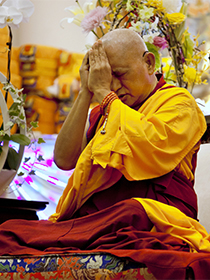- Home
- FPMT Homepage
Foundation for the Preservation of the Mahayana Tradition
The FPMT is an organization devoted to preserving and spreading Mahayana Buddhism worldwide by creating opportunities to listen, reflect, meditate, practice and actualize the unmistaken teachings of the Buddha and based on that experience spreading the Dharma to sentient beings. We provide integrated education through which people’s minds and hearts can be transformed into their highest potential for the benefit of others, inspired by an attitude of universal responsibility and service. We are committed to creating harmonious environments and helping all beings develop their full potential of infinite wisdom and compassion. Our organization is based on the Buddhist tradition of Lama Tsongkhapa of Tibet as taught to us by our founders Lama Thubten Yeshe and Lama Thubten Zopa Rinpoche.
- Willkommen
Die Stiftung zur Erhaltung der Mahayana Tradition (FPMT) ist eine Organisation, die sich weltweit für die Erhaltung und Verbreitung des Mahayana-Buddhismus einsetzt, indem sie Möglichkeiten schafft, den makellosen Lehren des Buddha zuzuhören, über sie zur reflektieren und zu meditieren und auf der Grundlage dieser Erfahrung das Dharma unter den Lebewesen zu verbreiten.
Wir bieten integrierte Schulungswege an, durch denen der Geist und das Herz der Menschen in ihr höchstes Potential verwandelt werden zum Wohl der anderen – inspiriert durch eine Haltung der universellen Verantwortung und dem Wunsch zu dienen. Wir haben uns verpflichtet, harmonische Umgebungen zu schaffen und allen Wesen zu helfen, ihr volles Potenzial unendlicher Weisheit und grenzenlosen Mitgefühls zu verwirklichen.
Unsere Organisation basiert auf der buddhistischen Tradition von Lama Tsongkhapa von Tibet, so wie sie uns von unseren Gründern Lama Thubten Yeshe und Lama Thubten Zopa Rinpoche gelehrt wird.
- Bienvenidos
La Fundación para la preservación de la tradición Mahayana (FPMT) es una organización que se dedica a preservar y difundir el budismo Mahayana en todo el mundo, creando oportunidades para escuchar, reflexionar, meditar, practicar y actualizar las enseñanzas inconfundibles de Buda y en base a esa experiencia difundir el Dharma a los seres.
Proporcionamos una educación integrada a través de la cual las mentes y los corazones de las personas se pueden transformar en su mayor potencial para el beneficio de los demás, inspirados por una actitud de responsabilidad y servicio universales. Estamos comprometidos a crear ambientes armoniosos y ayudar a todos los seres a desarrollar todo su potencial de infinita sabiduría y compasión.
Nuestra organización se basa en la tradición budista de Lama Tsongkhapa del Tíbet como nos lo enseñaron nuestros fundadores Lama Thubten Yeshe y Lama Zopa Rinpoche.
A continuación puede ver una lista de los centros y sus páginas web en su lengua preferida.
- Bienvenue
L’organisation de la FPMT a pour vocation la préservation et la diffusion du bouddhisme du mahayana dans le monde entier. Elle offre l’opportunité d’écouter, de réfléchir, de méditer, de pratiquer et de réaliser les enseignements excellents du Bouddha, pour ensuite transmettre le Dharma à tous les êtres. Nous proposons une formation intégrée grâce à laquelle le cœur et l’esprit de chacun peuvent accomplir leur potentiel le plus élevé pour le bien d’autrui, inspirés par le sens du service et une responsabilité universelle. Nous nous engageons à créer un environnement harmonieux et à aider tous les êtres à épanouir leur potentiel illimité de compassion et de sagesse. Notre organisation s’appuie sur la tradition guéloukpa de Lama Tsongkhapa du Tibet, telle qu’elle a été enseignée par nos fondateurs Lama Thoubtèn Yéshé et Lama Zopa Rinpoché.
Visitez le site de notre Editions Mahayana pour les traductions, conseils et nouvelles du Bureau international en français.
Voici une liste de centres et de leurs sites dans votre langue préférée
- Benvenuto
L’FPMT è un organizzazione il cui scopo è preservare e diffondere il Buddhismo Mahayana nel mondo, creando occasioni di ascolto, riflessione, meditazione e pratica dei perfetti insegnamenti del Buddha, al fine di attualizzare e diffondere il Dharma fra tutti gli esseri senzienti.
Offriamo un’educazione integrata, che può trasformare la mente e i cuori delle persone nel loro massimo potenziale, per il beneficio di tutti gli esseri, ispirati da un’attitudine di responsabilità universale e di servizio.
Il nostro obiettivo è quello di creare contesti armoniosi e aiutare tutti gli esseri a sviluppare in modo completo le proprie potenzialità di infinita saggezza e compassione.
La nostra organizzazione si basa sulla tradizione buddhista di Lama Tsongkhapa del Tibet, così come ci è stata insegnata dai nostri fondatori Lama Thubten Yeshe e Lama Zopa Rinpoche.
Di seguito potete trovare un elenco dei centri e dei loro siti nella lingua da voi prescelta.
- 欢迎 / 歡迎
简体中文
“护持大乘法脉基金会”( 英文简称:FPMT。全名:Foundation for the Preservation of the Mahayana Tradition) 是一个致力于护持和弘扬大乘佛法的国际佛教组织。我们提供听闻,思维,禅修,修行和实证佛陀无误教法的机会,以便让一切众生都能够享受佛法的指引和滋润。
我们全力创造和谐融洽的环境, 为人们提供解行并重的完整佛法教育,以便启发内在的环宇悲心及责任心,并开发内心所蕴藏的巨大潜能 — 无限的智慧与悲心 — 以便利益和服务一切有情。
FPMT的创办人是图腾耶喜喇嘛和喇嘛梭巴仁波切。我们所修习的是由两位上师所教导的,西藏喀巴大师的佛法传承。
繁體中文
護持大乘法脈基金會”( 英文簡稱:FPMT。全名:Found
ation for the Preservation of the Mahayana Tradition ) 是一個致力於護持和弘揚大乘佛法的國際佛教組織。我們提供聽聞, 思維,禪修,修行和實證佛陀無誤教法的機會,以便讓一切眾生都能 夠享受佛法的指引和滋潤。 我們全力創造和諧融洽的環境,
為人們提供解行並重的完整佛法教育,以便啟發內在的環宇悲心及責 任心,並開發內心所蘊藏的巨大潛能 — 無限的智慧與悲心 – – 以便利益和服務一切有情。 FPMT的創辦人是圖騰耶喜喇嘛和喇嘛梭巴仁波切。
我們所修習的是由兩位上師所教導的,西藏喀巴大師的佛法傳承。 察看道场信息:
- FPMT Homepage
- News/Media
-
- Study & Practice
-
-
- About FPMT Education Services
- Latest News
- Programs
- New to Buddhism?
- Buddhist Mind Science: Activating Your Potential
- Heart Advice for Death and Dying
- Discovering Buddhism
- Living in the Path
- Exploring Buddhism
- FPMT Basic Program
- FPMT Masters Program
- FPMT In-Depth Meditation Training
- Maitripa College
- Lotsawa Rinchen Zangpo Translator Program
- Universal Education for Compassion & Wisdom
- Online Learning Center
-
- Prayers & Practice Materials
- Overview of Prayers & Practices
- Full Catalogue of Prayers & Practice Materials
- Explore Popular Topics
- Benefiting Animals
- Chenrezig Resources
- Death & Dying Resources
- Lama Chopa (Guru Puja)
- Lama Zopa Rinpoche: Compendium of Precious Instructions
- Lama Zopa Rinpoche: Life Practice Advice
- Lama Zopa Rinpoche Practice Series
- Lamrim Resources
- Mantras
- Prayer Book Updates
- Purification Practices
- Sutras
- Thought Transformation (Lojong)
- Audio Materials
- Dharma Dates - Tibetan Calendar
- Translation Services
- Publishing Services
- Ways to Offer Support
- Prayers & Practice Materials
-
- Teachings and Advice
- Find Teachings and Advice
- Lama Zopa Rinpoche Advice Page
- Lama Zopa Rinpoche: Compendium of Precious Instructions
- Lama Zopa Rinpoche Video Teachings
- ༧སྐྱབས་རྗེ་བཟོད་པ་རིན་པོ་ཆེ་མཆོག་ནས་སྩལ་བའི་བཀའ་སློབ་བརྙན་འཕྲིན།
- Podcasts
- Lama Yeshe Wisdom Archive
- Buddhism FAQ
- Dharma for Young People
- Resources on Holy Objects
- Teachings and Advice
-
-
*If a menu item has a submenu clicking once will expand the menu clicking twice will open the page.
-
-
- Centers
-
- Teachers
-
- Projects
-
-
-
-
*If a menu item has a submenu clicking once will expand the menu clicking twice will open the page.
-
-
- FPMT
-
-
-
-
-
We should train ourselves not to become engrossed in any of the thoughts continuously arising in our mind. Our consciousness is like a vast ocean with plenty of space for thoughts and emotions to swim about and we should not allow our attention to be distracted by any of them.
Lama Thubten Yeshe
-
-
-
- Shop
-
-
-
The Foundation Store is FPMT’s online shop and features a vast selection of Buddhist study and practice materials written or recommended by our lineage gurus. These items include homestudy programs, prayers and practices in PDF or eBook format, materials for children, and other resources to support practitioners.
Items displayed in the shop are made available for Dharma practice and educational purposes, and never for the purpose of profiting from their sale. Please read FPMT Foundation Store Policy Regarding Dharma Items for more information.
-
-
Lama Zopa Rinpoche News and Advice
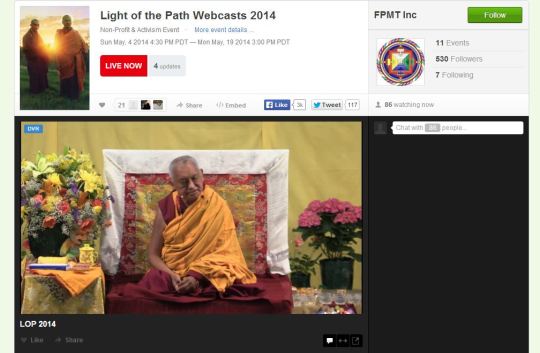
Lama Zopa Rinpoche while teaching at Light of the Path retreat as seen via webcast
Lama Zopa Rinpoche’s teachings at the Light of the Path retreat are being streamed live in English, Spanish and French!
Rinpoche is expected to teach one or two times each day during the two-week retreat that began on Sunday, May 4, 2014, in North Carolina, US. The schedule of teachings will be shared as it becomes available.
The details of the three live webcasts:
- English on FPMT Livestream page: https://new.livestream.com/FPMT/lop2014
- Spanish on alternative FPMT Livestream page: https://new.livestream.com/fpmtinc/lop2014ES
- French on justreality Livestream page: http://new.livestream.com/accounts/1581856/events/2974873?cat=event&query
Video recordings of the teachings will be made available as soon as possible.
More information, photos, schedule and updates about FPMT spiritual director Lama Zopa Rinpoche can be found on Rinpoche’s homepage. If you’d like to receive news of Lama Zopa Rinpoche via email, sign up to Lama Zopa Rinpoche News.
- Tagged: lama zopa rinpoche, light of the path, webcast
- 0
5
Lama Zopa Rinpoche Teaches at Kadampa Center
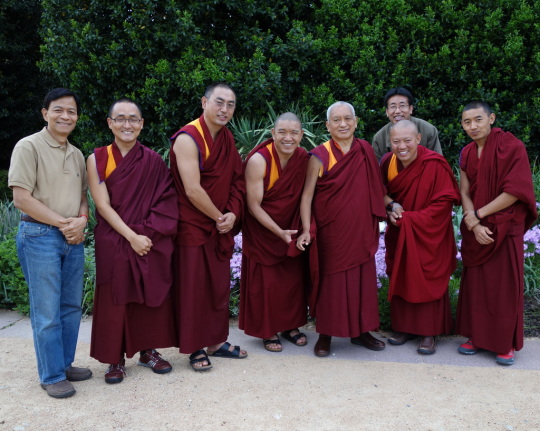
Lama Zopa Rinpoche with Geshe Gelek, Kadampa Center resident geshe; Geshe Tenley, Kurukulla Center resident geshe; Geshe Sangpo; Damcho, the translator; Rinpoche’s attendants Vens. Sangpo and Sherab; and Rinpoche’s host Mr. Son Pham out for a walk in the park in Raleigh, North Carolina, US, May 2014. Photo by Ven. Roger Kunsang.
Lama Zopa Rinpoche arrived in North Carolina and visited Kadampa Center in Raleigh on Saturday, May 3. During the one-day visit, Rinpoche taught on the Eight Verses of Thought Transformation.
The following day, Rinpoche traveled to the Light of the Path retreat at a retreat center in the North Carolina Smoky Mountains. More than 200 students are participating in the two-week retreat with Rinpoche.
You can watch video from the retreat, including live streaming of teachings as they happen, on the Light of the Path webcast page! Visit the page now to see when the next live webcast is scheduled.
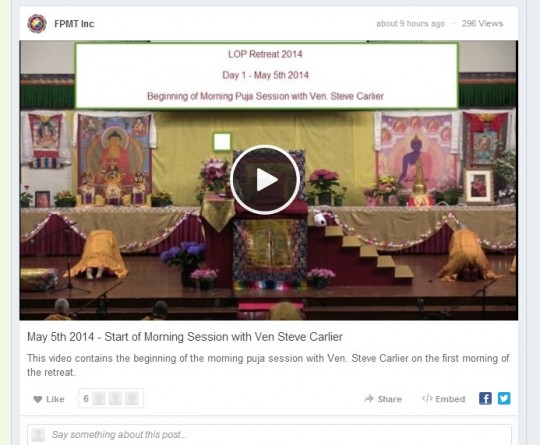
Screen shot of Light of the Path webcast page
More information, photos, schedule and updates about FPMT spiritual director Lama Zopa Rinpoche can be found on Rinpoche’s homepage. If you’d like to receive news of Lama Zopa Rinpoche via email, sign up to Lama Zopa Rinpoche News.
- Tagged: lama zopa rinpoche, light of the path, mandala, ven. steve carlier, webcast
- 0
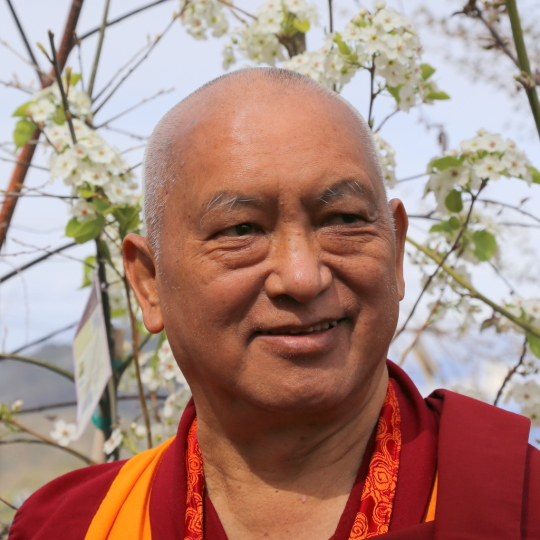
Lama Zopa Rinpoche in northcentral Washington, US, April 2014. Photo by Ven. Thubten Kunsang.
Beginning on Sunday, May 4, Lama Zopa Rinpoche’s teachings at the Light of the Path retreat will be webcast live for students around the world to watch. The teaching on Sunday is scheduled to begin at 7:30 p.m. EDT (4:30 p.m. PDT, 11:30 p.m. UTC; Monday, May 5, 5:00 a.m. IST, 9:30 a.m. AEST). Video recordings of the teachings will be made available as quickly as possible in English, Spanish and French.
The Light of the Path Retreat 2014, hosted by Kadampa Center in North Carolina, US, is the third of a five-year series of teaching retreats led by Lama Zopa Rinpoche based on Lama Atisha’s text, Lamp for the Path to Enlightenment. The first two retreats took place in 2009 and 2010 and many resources and materials have been developed from these precious teachings:
- All teachings from the 2009 and 2010 Light of the Path retreats are freely available in the resources area of the FPMT Online Learning Center.
- MP3 audio and MP4 video files are available for download in the Light of the Path Retreat Materials 2009, 2010 and 2014 course. This course also contains the root text and other information associated with the retreat, including reviews, guided meditations, and the complete transcript of the retreat.
- The Living in the Path online program has been created from the Light of the Path retreat teachings of 2009 and 2010. Organized into structured modules you will find this, and other, programs on the FPMT Online Learning Center.
For updates on the live webcast schedule and news on the video recordings, please see the FPMT website and the FPMT Facebook page.
More information, photos, schedule and updates about FPMT spiritual director Lama Zopa Rinpoche can be found on Rinpoche’s homepage. If you’d like to receive news of Lama Zopa Rinpoche via email, sign up to Lama Zopa Rinpoche News.
- Tagged: kadampa center, lama zopa rinpoche, light of the path, webcast
- 0
2
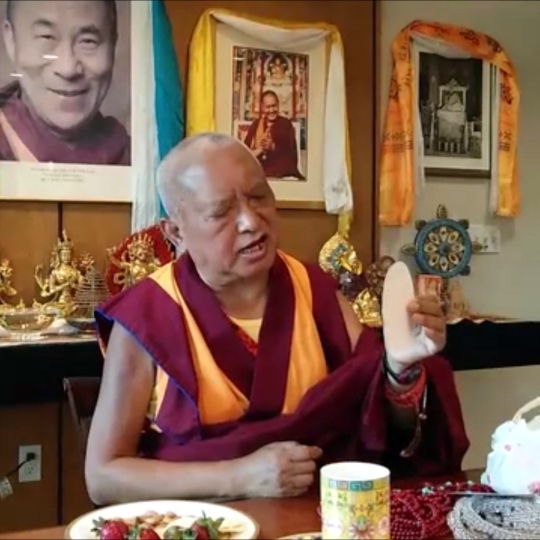
Lama Zopa Rinpoche explaining the benefits of the Namgyälma mantra at the FPMT International Office in Portland, Oregon, US, April 2014. Photo by Mandala.
While visiting the FPMT International Office, Lama Zopa Rinpoche carefully explained the benefits of carrying the powerful Namgyälma mantra and having it on one’s car and home. Rinpoche offered Namgyälma amulets and decals to staff. Rinpoche explained that if you are carrying a paper version of the mantra on your body, you need to protect it in plastic. He then explained how to use it in this video.
The FPMT Foundation Store carries many items with the Namgyälma mantra, including cards and decals.
Lama Zopa Rinpoche is the spiritual director of the Foundation for the Preservation of Mahayana Tradition (FPMT), an organization dedicated to preserving Mahayana Buddhism through offering the Buddha’s authentic teachings and to facilitating reflection, meditation, practice and the opportunity to actualize and directly experience the Buddha’s teachings. Sign up to receive news and updates.
- Tagged: lama zopa rinpoche, mandala, namgyalma mantra, video
- 0
30
‘Dharma Protects You From Suffering’
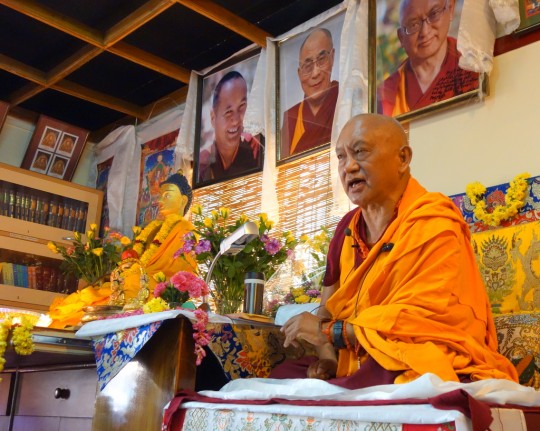
Lama Zopa Rinpoche on the first day of teaching at Choe Khor Sum Ling Study Group, Bangalore, India, March 2014. Photo by Ven. Roger Kunsang.
FPMT Spiritual Director Lama Zopa Rinpoche offered a week of teachings at Choe Khor Sum Ling Study Group in Bangalore, India, in March 2014. Ven. Roger Kunsang, Rinpoche’s assistant and CEO of FPMT, Rinpoche shared that Rinpoche gave animated and dynamic teachings on emptiness that were “so clear on the subtle aspects.” Rinpoche also enthusiastically taught on Dharma practice, the meaning of refuge and the importance of Dharma.
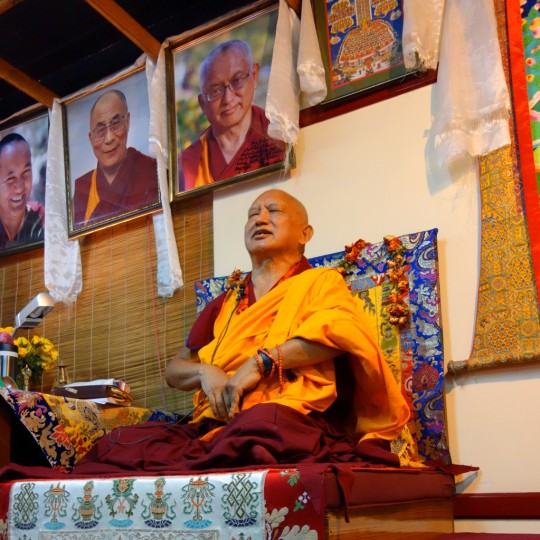
Lama Zopa Rinpoche teaching at Choe Khor Sum Ling Study Group, Bangalore, India, March 2014. Photo by Ven. Roger Kunsang.
According to Ven. Roger, Rinpoche said: “Dharma protects you from suffering. Happiness and suffering come from the mind … so protect your mind … keep your mind content … cultivate happiness from within!”

Lama Zopa Rinpoche at Choe Khor Sum Ling Study Group, Bangalore, India, March 2014. Photo by Ven. Roger Kunsang.
Ven. Roger also shared that Rinpoche said: “Milarepa had nothing and yet was always blissful! Many people have everything materially and are still unhappy. … True lasting happiness comes from within. … Satisfaction and contentment are mental states. … These inner qualities don’t depend on outside things.”
Lama Zopa Rinpoche is the spiritual director of the Foundation for the Preservation of Mahayana Tradition (FPMT), an organization dedicated to preserving Mahayana Buddhism through offering the Buddha’s authentic teachings and to facilitating reflection, meditation, practice and the opportunity to actualize and directly experience the Buddha’s teachings. Sign up to receive news and updates.
- Tagged: choe khor sum ling, lama zopa rinpoche
- 0
28
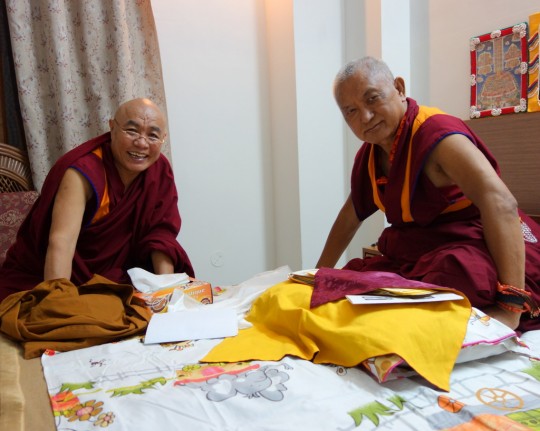
Lama Zopa Rinpoche discussing with Ven. Lobsang Norbu Shastra, a Sanskrit scholar at Sarnath University, the meaning and pronunciation of certain mantras, Sarnath, India, March 2014. Photo by Ven. Roger Kunsang.
Lama Zopa Rinpoche’s devotion manifests in a natural curiosity to learn mantras in the original Sanskrit when possible and appropriate. Rinpoche later uses what he learns to bless people and animals that he comes across, such when once Rinpoche met a small bird in a garden store:
Lama Zopa Rinpoche is the spiritual director of the Foundation for the Preservation of Mahayana Tradition (FPMT), an organization dedicated to preserving Mahayana Buddhism through offering the Buddha’s authentic teachings and to facilitating reflection, meditation, practice and the opportunity to actualize and directly experience the Buddha’s teachings. Sign up to receive news and updates.
- Tagged: animals, lama zopa rinpoche, mantra
- 0
28
In this touching video, Lama Zopa Rinpoche meets the children of the Ngari Institute of Buddhist Dialectics in Ladakh, India. Rinpoche is listening to the children reciting many prayers that they have memorized. Lama Zopa Rinpoche, through the Lama Zopa Rinpoche Bodhichitta Fund, is sponsoring all the food for the children this year. This is the second year that Rinpoche has offered this.
25
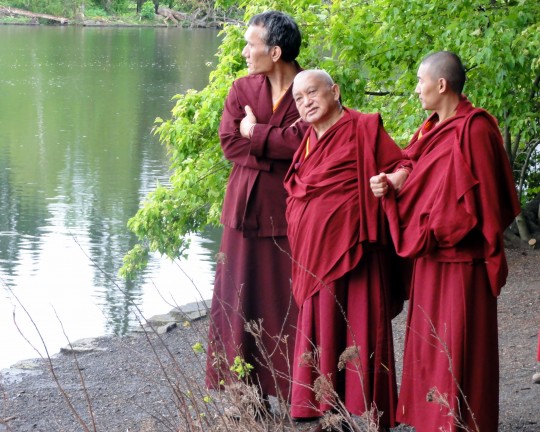
Lama Zopa Rinpoche with Yangsi Rinpoche (left) and Ven. Sangpo visiting Crystal Springs Rhododendron Garden in Portland, Oregon, US, April 2014. Photo by Ven. Holly Ansett.
“Great compassion is generated by depending on the kindness of this person who is suffering and deluded – this person who we call the enemy.
“… This person who we call “enemy” is the most important thing in our life and we should do anything that we can to help this person. If the person is carrying a heavy load, then we can share the load. We can help to carry some of the load so the person doesn’t suffer, or we can carry the whole load or make it lighter. Even something small, like offering our seat to this person in the car, becomes so important.
“Even a small amount of help or some small benefit is most important for us and it gives us great joy. If we can offer some small comfort to that person, it gives us incredible joy, because that person is the dearest and the most precious and kind in our life. So every single action that we can do to help, or any comfort that we can offer, is so precious.”
– Lama Zopa Rinpoche, from Service as a Path to Enlightenment, from FPMT Education Services
Lama Zopa Rinpoche is the spiritual director of the Foundation for the Preservation of Mahayana Tradition (FPMT), an organization dedicated to preserving Mahayana Buddhism through offering the Buddha’s authentic teachings and to facilitating reflection, meditation, practice and the opportunity to actualize and directly experience the Buddha’s teachings. Sign up to receive news and updates.
24
Video from Lama Zopa Rinpoche’s Teachings in Portland
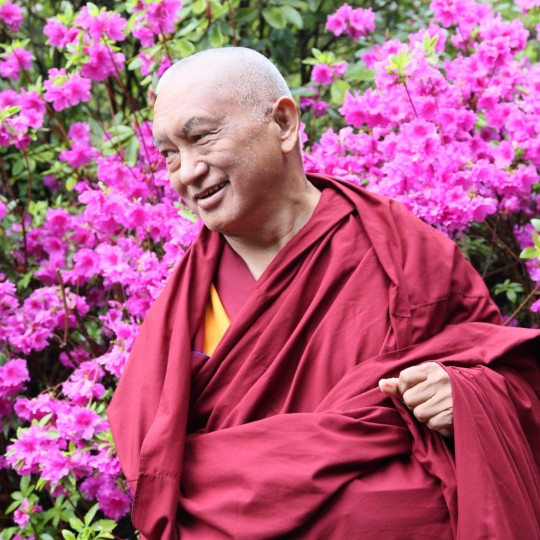
Lama Zopa Rinpoche in Portland, Oregon, US, April 2014. Photo by Ven. Thubten Kunsang.
In case you missed the live webcast, you can watch the recorded video from Lama Zopa Rinpoche’s preliminary teachings while he was at Maitripa College in Portland, Oregon, April 19-22. While at Maitripa, Rinpoche gave a Vajrasattva initiation, an oral transmission of Dorje Khadro and a White Tara long life empowerment.
During Rinpoche’s visit to Portland, he also met with the board and staff of FPMT International Office, which shares a building with Maitripa College. Rinpoche gave advice on current and future projects and activities for the worldwide organization.
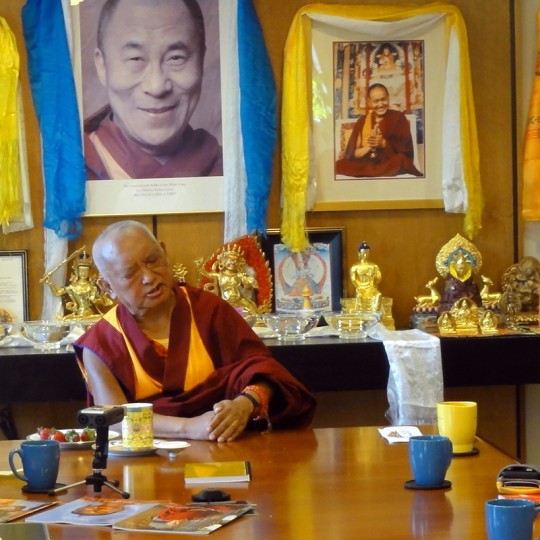
Lama Zopa Rinpoche offering advice to International Office staff, FPMT International Office, Portland, Oregon, April 2014. Photo by Ven. Holly Ansett.
More information, photos, schedule and updates about FPMT spiritual director Lama Zopa Rinpoche can be found on Rinpoche’s homepage. If you’d like to receive news of Lama Zopa Rinpoche via email, sign up to Lama Zopa Rinpoche News.

Lama Zopa Rinpoche at Buddha Amitabha Pure Land, Riverside, Washington, US, April 2014. Photo by Ven. Thubten Kunsang.
“Usually we have attachment to so many different things, or to having many of a similar object, e.g. a wife, husband, girlfriend or boyfriend, sexual relationships, etc. — wanting many or not being content with one. Or wanting more money; when we have one thousand dollars, wanting ten thousand dollars, then a million, then a billion, it is endless. Then, to get more, one engages in the ten non-virtues, cheats or even kills others. Then one gets into trouble and receives punishment, is sent to prison, and becomes famous for having a negative mind, a bad reputation.
“Contentment means not needing more than you have or wanting what you don’t have. You can understand it better if you think of renunciation. It is similar, bringing peace in the heart by healing the mental sickness of attachment.”
– Lama Zopa Rinpoche, from Service as a Path to Enlightenment, from FPMT Education Services
Lama Zopa Rinpoche is the spiritual director of the Foundation for the Preservation of Mahayana Tradition (FPMT), an organization dedicated to preserving Mahayana Buddhism through offering the Buddha’s authentic teachings and to facilitating reflection, meditation, practice and the opportunity to actualize and directly experience the Buddha’s teachings. Sign up to receive news and updates.
- Tagged: attachment, lama zopa rinpoche, mandala
- 0
22
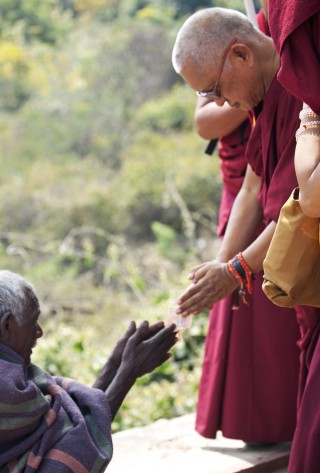
Lama Zopa Rinpoche making an offering to a beggar on the way up to Vulture’s Peak, India, March 2014. Photo by Andy Melnic.
The sheer volume of compassionate activity undertaken by Lama Zopa Rinpoche every year, day in and day out, is astounding. The Lama Zopa Rinpoche Bodhichitta Fund was established to enable Rinpoche’s kindness and generosity to flourish around the world.
You can now have all news from this fund delivered to your email inbox. Subscribe here and never miss a thing!
22
LIVE Video Webcast: Lama Zopa Rinpoche, Tuesday, April 22
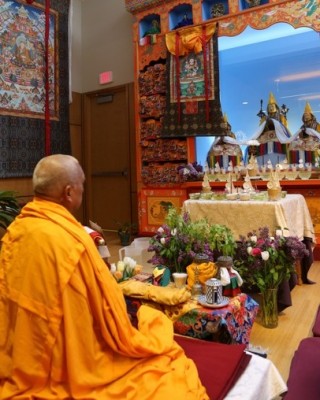
Lama Zopa Rinpoche at Maitripa College, Portland, Oregon, US, April 19, 2014. Photo by Ven. Thubten Kunsang.
Lama Zopa Rinpoche offers a White Tara Long Life Empowerment on Tuesday, April 22, at Maitripa College in Portland, Oregon, US. You can watch a live video webcast of the preliminary teachings on FPMT’s Livestream page. The webcast is scheduled to beginning at 10 a.m. PDT.
The empowerment coincides with the birthday of Maitripa president Yangsi Rinpoche and caps off a weekend of many precious blessings with Lama Zopa Rinpoche.
More information, photos, schedule and updates about FPMT spiritual director Lama Zopa Rinpoche can be found on Rinpoche’s homepage. If you’d like to receive news of Lama Zopa Rinpoche via email, sign up to Lama Zopa Rinpoche News.
- Home
- News/Media
- Study & Practice
- About FPMT Education Services
- Latest News
- Programs
- New to Buddhism?
- Buddhist Mind Science: Activating Your Potential
- Heart Advice for Death and Dying
- Discovering Buddhism
- Living in the Path
- Exploring Buddhism
- FPMT Basic Program
- FPMT Masters Program
- FPMT In-Depth Meditation Training
- Maitripa College
- Lotsawa Rinchen Zangpo Translator Program
- Universal Education for Compassion & Wisdom
- Online Learning Center
- Prayers & Practice Materials
- Overview of Prayers & Practices
- Full Catalogue of Prayers & Practice Materials
- Explore Popular Topics
- Benefiting Animals
- Chenrezig Resources
- Death & Dying Resources
- Lama Chopa (Guru Puja)
- Lama Zopa Rinpoche: Compendium of Precious Instructions
- Lama Zopa Rinpoche: Life Practice Advice
- Lama Zopa Rinpoche Practice Series
- Lamrim Resources
- Mantras
- Prayer Book Updates
- Purification Practices
- Sutras
- Thought Transformation (Lojong)
- Audio Materials
- Dharma Dates – Tibetan Calendar
- Translation Services
- Publishing Services
- Teachings and Advice
- Find Teachings and Advice
- Lama Zopa Rinpoche Advice Page
- Lama Zopa Rinpoche: Compendium of Precious Instructions
- Lama Zopa Rinpoche Video Teachings
- ༧སྐྱབས་རྗེ་བཟོད་པ་རིན་པོ་ཆེ་མཆོག་ནས་སྩལ་བའི་བཀའ་སློབ་བརྙན་འཕྲིན།
- Podcasts
- Lama Yeshe Wisdom Archive
- Buddhism FAQ
- Dharma for Young People
- Resources on Holy Objects
- Ways to Offer Support
- Centers
- Affiliates Area
- Teachers
- Projects
- Charitable Projects
- Make a Donation
- Applying for Grants
- News about Projects
- Other Projects within FPMT
- Support International Office
- Projects Photo Galleries
- Give Where Most Needed
- FPMT
- Shop
Translate*
*powered by Google TranslateTranslation of pages on fpmt.org is performed by Google Translate, a third party service which FPMT has no control over. The service provides automated computer translations that are only an approximation of the websites' original content. The translations should not be considered exact and only used as a rough guide.If your daily life is tremendously involved in emotions, you are completely driven by them and psychologically tired. In other words, our physical emotions get too involved and we don’t understand the functioning of our six sense consciousnesses.







